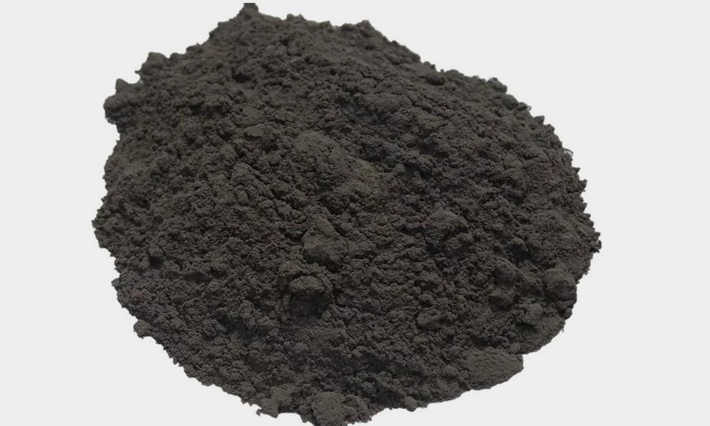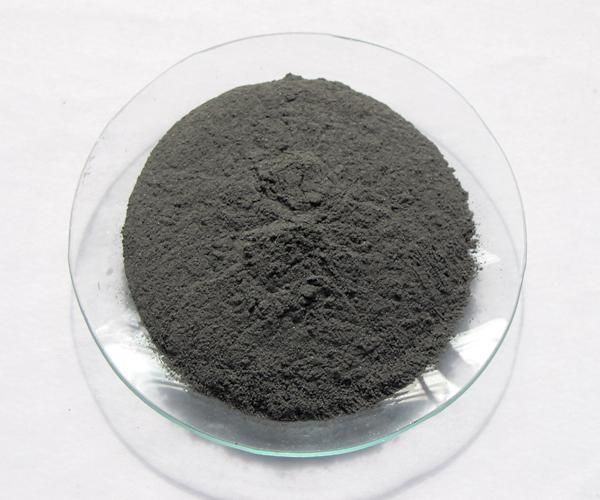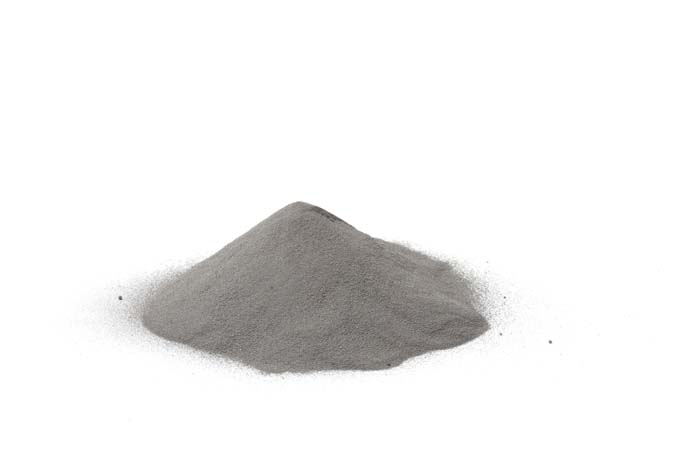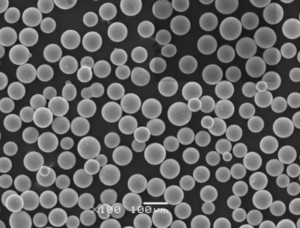概要
AISI 316Lステイン鉄粉レス は、合金元素としてモリブデンを含むステンレス鋼粉末の一種である。オーステナイト系ステンレス鋼の300シリーズに属する。以下は、AISI 316Lステンレス鋼粉末の主な詳細です:
- 構成: Fe, Cr (16-18%), Ni (10-14%), Mo (2-3%), Mn, Si, P, S
- プロパティ 優れた耐食性、優れた耐熱性、高い延性と強度、非磁性
- アプリケーション 3Dプリンティング, 射出成形, 積層造形, 金属射出成形
- 粒子の形状: 球形、不規則
- サイズ 15-45ミクロン、10-100ミクロン、その他
- 生産方法: ガスアトマイズ、水アトマイズ、プラズマアトマイズ
AISI316L粉末は、選択的レーザー焼結、ダイレクトメタルレーザー焼結、バインダージェッティングなどの高度な製造プロセスを用いて複雑な金属部品を製造するための汎用性の高い材料です。印刷適性、耐食性、生体適合性、高強度などの主な特性により、航空宇宙、自動車、医療、化学処理などの用途に適しています。
AISI 316Lステンレス鋼粉末の種類
316Lステンレス鋼粉末は、製造方法と粒子の特性によって分類されるいくつかの主要な種類があります:
| タイプ | 製造方法 | 粒子形状 | 粒子サイズ |
|---|---|---|---|
| ガスアトマイズド | ガス噴霧 | ほとんどが球形 | 15-45ミクロン |
| 水アトマイズド | 水の霧化 | 不規則な衛星粒子 | 最大100ミクロン |
| プラズマアトマイズ | プラズマ霧化 | 球形度が高い | 15-45ミクロン |
| カルボニル鉄粉 | 熱分解 | 球形 | 10ミクロン以下 |
ガス噴霧 316Lパウダーは、最も球状で粒度分布の狭い粒子を生成します。添加剤製造のための優れた流動性と展延性を有する。
霧化された水 パウダーはより不規則な形状で、サテライト粒子を含む。粒子径の分布がより広い場合もある。
プラズマ霧化 パウダーは非常に高い真球度と流動性を持つ。微細な形状や滑らかな表面の印刷に最適です。
カルボニル鉄粉 は10ミクロン以下の最小粒径を持つ。焼結用途に使用される。

316Lステンレス鋼粉末の特徴
AISI 316Lステンレス鋼粉末の主な特徴を以下に示す:
- 粒子の形状: 球状でサテライトのない粒子が最も流動性に優れています。不規則な粒子は、印刷時にパウダーの広がりが悪くなることがあります。
- 粒子径: 一般的な範囲は15~45ミクロン。10ミクロン以下の小さな粒子は発塵の原因となる。100ミクロン以上の大きな粒子は、表面仕上げ不良の原因となります。
- 粒度分布: タイトな分布のパウダーは、均一な溶融と安定した材料特性を保証します。
- 流動性: 球状粉末は、見かけ密度やホール流速で測定した流動性に優れている。不規則な粉末は流動性が低くなることがある。
- タップの密度: タップ密度を高くすると、パウダーベッド密度が向上し、最終的な部品密度が向上する。値の範囲は3.5~4.5g/ccです。
- 純粋さ: 多孔性と酸化を避けるためには、酸素と窒素の含有量が少ない高純度が必要です。医療グレードのパウダーは最も純度が高い。
- 含水率: 吸湿は粉末の凝集を引き起こし、流動性に影響を与える。含水率は0.3%以下に保つ必要がある。
316Lステンレスパウダーの用途
AISI316L粉末は、その優れた耐食性と高温強度により、以下の用途で使用されています:
| 産業 | 用途 |
|---|---|
| 航空宇宙 | 航空機部品、タービン、エンジン部品 |
| 自動車 | バルブ、ピストン、ターボチャージャー・ローター |
| メディカル | インプラント、補綴物、手術器具 |
| マリン | ボートのプロペラ、海上プラットフォーム |
| ケミカル | ポンプ、バルブ、パイプ |
| 石油・ガス | ダウンホールツール、坑口部品 |
その他の用途としては、食品加工機器、熱交換器、極低温容器、建築、宝飾品などがある。316Lは生体適合性に優れているため、歯科用インプラントや医療機器に適している。
3Dプリンティングプロセスによって可能になる微細な解像度と幾何学的な自由度は、業界全体にわたって316Lステンレス鋼部品の設計領域を拡大します。
316Lステンレスパウダーの仕様
316Lステンレス鋼粉末は以下の仕様に適合する:
| 仕様 | 詳細 |
|---|---|
| ASTM規格 | アストレムA240、アストレムF3056、アストレムF3301 |
| UNS番号 | S31603 |
| 密度 | 7.9-8.1 g/cc |
| 極限引張強さ | ~485-620 MPa |
| 降伏強度 | ~170-310 MPa |
| 伸び | ~40-50% |
| 融点範囲 | 1370-1400°C |
| EH(エクストラ・ハード)グレード | 酸素含有量 0.1%以下 |
| SH(ソフト/高純度)グレード | 酸素含有量 0.03%マックス |
組成と機械的特性は、粉末サプライヤーによって異なる場合がある。酸素含有量が高くなると、延性や耐食性に悪影響を及ぼす可能性があります。重要な用途には超低酸素パウダーもあります。
316L粉末の設計上の考慮事項
316Lステンレス鋼粉を使用する際の設計上のヒントをいくつかご紹介します:
- 十分な強度を確保するため、最小肉厚は0.8~1mmとする。
- 垂直な壁の代わりに、30~45°の角度のある面を使用する。
- ゆとりのあるフィレットとカーブでストレスを軽減
- プロセス・パラメーターを最適化することにより、気孔率を最小化することができる。
- 熱間等方圧加圧(HIP)のような後加工は、高密度化を改善する。
- 外観上および機能上の理由から、表面仕上げの工程が必要となる場合がある。
- 変形を避けるため、印刷時には支持構造が必要である。
入念な部品設計と造形の方向付けは、表面欠陥、残留応力、歪みの回避に役立つ。また、材料特性を向上させるためにプロセスパラメーターを調整することもできます。
316Lステンレス鋼粉末のサプライヤー
評判の高い316Lステンレス鋼粉末のメーカーやサプライヤーは数多くある:
| 会社概要 | 国名 | グレード | 粒子径 |
|---|---|---|---|
| サンドビック | スウェーデン | オスプレイ316L、EH、SH | 15-45μm |
| カーペンター・パウダー製品 | アメリカ | 316L-Si、316L-Mo | 15-45μm |
| プラクセア | アメリカ | 316L、316L-SH | 10-45μm |
| ヘガネス | スウェーデン | 316L | 20-65μm |
| LPWテクノロジー | 英国 | 316L-真空溶解 | 15-53μm |
| CNPC 粉末グループ | 中国 | 316L | 15-100μm |
価格は、注文量、粒度分布、形状、純度に基づき、キログラム当たり50~150ドル。特注の粒子サイズや組成も可能。

316Lパウダープリンターの設置、操作、メンテナンス
積層造形用の316L粉末を使用するには、適切な設置、操作、メンテナンス手順が必要です:
- プリンターは、メーカーの指示に従い、温度と湿度が管理された環境に設置する必要があります。
- 不活性ガスの流量は、ビルド中の酸化を避けるために正しく設定する必要があります。
- 均一な粉体層を確保するには、リコーター機構の定期的な校正が必要です。
- システム内の漏れは、吸湿やパウダーの劣化につながる可能性がある
- 未使用のパウダーは、乾燥剤入りの密閉容器で保管できる。
- 頻繁にシステムを清掃し、こぼれた粉を取り除くことにより、火災の危険を防止する。
- 光学部品、フィルター、モーターの推奨予防保守スケジュールに従うこと
- リコーター・ブレードやピストンなど、損傷または摩耗した部品は交換する。
- 微粉末を取り扱う際は、健康被害を避けるため、マスク、手袋、ゴーグルなどのPPEを必ず着用すること。
316Lステンレス鋼で高品質な印刷を繰り返し行うには、適切な設置、環境、メンテナンスが不可欠です。
316Lパウダーサプライヤーの選び方
ここでは、316Lステンレス鋼粉末サプライヤーを選択するためのいくつかのヒントを示します:
- 品質基準: ISO 9001およびAS9100認証は、品質管理プロセスを証明するものである。
- 粉末の特性評価: 粒子の形状、粒度分布、流量、密度、組成のデータを提供すること。
- プロセス制御: 最適化された製造工程による一貫した粉末形態と清浄度
- テスト能力: 粒子径、化学分析、微細構造に関する社内試験が望ましい。
- 業界経験: 航空宇宙、医療、自動車分野への粉末供給年数
- パウダーの範囲: 様々な用途に応じたカスタム合金、粒子サイズの製造能力
- 研究開発能力: 粉末の特性や適格性試験を調整する冶金学の専門知識
- 応答性: 評価用小型R&A;Dサンプルの迅速なターンアラウンド
- カスタマーサービス: 粉末冶金および積層造形に関する技術的専門知識
- 資格: 医療業界向けISO 13485、航空宇宙業界向けAS9100
- 価格設定: 数量、リードタイム、パウダーのカスタマイズに基づくバランス
大量注文の前に、パウダーの品質と印刷適性を確認するためにサンプルを評価する必要があります。
316L粉末の利点と限界
| メリット | 制限事項 |
|---|---|
| 優れた耐食性 | コバルトクロム合金より低い耐摩耗性 |
| 医療用の生体適合性 | 孔食や隙間腐食に弱い |
| 高い延性と衝撃強度 | 表面仕上げを改善するために後加工が必要な場合がある。 |
| 800℃までの耐酸化性 | 気孔率の問題は、プロセス・パラメータが不適切な場合に発生する可能性がある。 |
| 良好な溶接性と成形性 | 炭素鋼粉末に比べて高価 |
| 性能向上のため、特別低酸素仕様も用意 | ニッケル合金よりも高い熱伝導性 |
316L粉末は、比較的高いコストで、機械的特性、溶接性、耐食性のバランスに優れています。プロセスの最適化は、緻密化と材料特性の最大化に役立ちます。

よくある質問
Q: 316Lパウダーは医療用インプラントに安全ですか?
A: はい、316L粉末は生体適合性が高く、整形外科や歯科のインプラントの印刷に一般的に使用されています。医療グレードの純度と清浄度の基準を満たしていることを確認してください。
Q: 316Lパウダーは応力除去が必要ですか?
A: 印刷後、残留応力を除去するために応力除去熱処理を行うことを推奨します。一般的な熱処理は650℃で1~2時間です。
Q: 316Lと304Lの粉末グレードを混合できますか?
A: 素材の性質が異なると、予想外の性能を発揮する可能性があるため、お勧めできません。
Q:316Lパウダーで微細形状を印刷するには、どの程度の粒径が最適ですか?
A:高解像度と表面仕上げのためには、通常15~25ミクロンの微細なパウダーが好ましい。しかし、粒子が小さいと流動性が低下します。
Q: 316Lは海水環境でも耐食性がありますか?
A: はい、316Lは耐塩化物腐食性に優れており、海洋用途に広く使用されています。
Q: ステンレス鋼の316等級と316L等級の違いは何ですか?
A: 316Lは炭素含有量が低い(最大0.03%)ため、溶接や積層造形の耐食性が向上します。
Q: 316Lパウダーは熱間静水圧プレス(HIP)の後処理が必要ですか?
A: HIPは高密度化と材料特性の向上に役立ちますが、必須ではありません。パラメータの最適化により、気孔率を最小化することもできます。
Q: 316Lパウダーの保存可能期間はどのくらいですか?
A: 316Lパウダーは、密封された容器で適切に保管された場合、再校正が必要となるまでの保存可能期間は1~5年です。
Q: 316Lパウダーは再利用可能ですか?
A: はい、316L の未使用パウダーは回収、ふるい分け、再利用が可能です。しかし、再利用された粉末は特性のばらつきが大きくなります。
Frequently Asked Questions (FAQ)
1) What powder type is best for LPBF with AISI 316L Stainless Steel Powder?
- Gas-atomized or plasma-atomized 15–45 μm with high sphericity (>0.93), tight PSD, low satellites, and low O/N for reliable spreadability and density.
2) How does oxygen/nitrogen content affect 316L AM properties?
- Higher O/N increases strength but reduces ductility and fatigue. For AM-grade 316L, many specs target O ≤0.05–0.08 wt% and N ≤0.03 wt% to balance toughness and corrosion resistance.
3) Can water-atomized 316L be used for binder jetting?
- Yes. Water-atomized 316L with post-spheroidization and narrow PSD is widely used in binder jetting, followed by debind/sinter to achieve near-wrought properties.
4) Do 316L AM parts require HIP?
- HIP is recommended for critical components to close internal porosity and improve fatigue/leak tightness. Noncritical parts may rely on parameter optimization plus stress relief.
5) What are typical post-processing steps for 316L AM?
- Stress relief (~650–800°C), HIP as needed, machining of critical surfaces, surface finishing (shot peen, blasting, electropolish), and passivation per ASTM A967 to maximize corrosion performance.
2025 Industry Trends: AISI 316L Stainless Steel Powder
- Digital powder passports: Lot-level PSD (D10/D50/D90), O/N/H, flow, tap density, and reuse count integrated with COAs for faster qualification.
- Binder jetting scale-up: Broader adoption of lower-cost 316L BJ powders with improved spheroidization and sintering profiles for serial production.
- Sustainability: Argon recirculation and humidity-controlled storage extend reuse cycles (5–10 blends) while maintaining corrosion properties.
- Surface integrity focus: Electropolishing and hybrid machining strategies standardized to reach Ra < 1–3 μm on fluid-path and medical surfaces.
- Regulatory alignment: Increased use of ASTM F3184/F3301 guidance and standardized artifacts to correlate powder KPIs with CT and mechanical results.
2025 KPI Snapshot for 316L AM Powders and Parts (indicative ranges)
| メートル | 2023 Typical | 2025 Typical | Notes/Sources |
|---|---|---|---|
| Sphericity (GA/Plasma, 15–45 μm) | 0.92–0.95 | 0.94–0.97 | Improved atomization/sieving |
| Oxygen (wt%) | 0.06–0.10 | 0.04–0.08 | Better inert handling/drying |
| Hall flow (s/50 g) | 22–30 | 20–26 | ASTM B213 |
| Tap density (g/cm³) | 3.6–4.2 | 3.8–4.4 | PSD optimization |
| LPBF relative density (as-built) | 99.2–99.6% | 99.5–99.9% | HIP ≥99.9% |
| Corrosion (ASTM A262 Prac E, sensitization) | Pass with processing | Pass with margin | Proper heat control/passivation |
References: ISO/ASTM 52907; ASTM B212/B213/B703; ASTM E1409/E1447 (O/H); ASTM F3184 (metal PBF systems); ASTM F3301 (metal PBF data reporting); ASTM A967 (passivation); OEM application notes (EOS, Renishaw, SLM Solutions); NIST AM‑Bench
Latest Research Cases
Case Study 1: Electropolished 316L LPBF Manifolds for Chemical Processing (2025)
Background: A chemical equipment OEM needed crevice-resistant manifolds with internal channels and smooth bores.
Solution: Used gas-atomized AISI 316L Stainless Steel Powder (D50 ≈ 32 μm, O = 0.05 wt%); LPBF with high-gas-flow optics; stress relief at 750°C; targeted HIP; internal electropolish via flow-loop chemistry; passivation per ASTM A967.
Results: Internal Ra reduced from 12–16 μm to 1.8–2.5 μm; CT porosity <0.05% after HIP; chloride pitting resistance improved (no pits at 1000 h, 3.5% NaCl, 25°C); lead time −42% vs casting + drilling.
Case Study 2: Binder-Jet 316L Tooling Inserts with Conformal Cooling (2024)
Background: A moldmaker sought lower-cost conformal inserts with improved cycle time.
Solution: Qualified water-atomized 316L post-spheroidized powder (20–65 μm) for binder jetting; optimized debind/sinter profile; applied shot peen and selective machining on sealing faces.
Results: Powder cost −22% vs GA LPBF route; density 97–98.5% (BJ+sinter) with no leaks after impregnation; molding cycle time −18%; ROI < 9 months.
Expert Opinions
- Dr. John Slotwinski, Materials Research Engineer, NIST
Key viewpoint: “Linking powder PSD and O/N/H to CT-measured porosity and fatigue data is central to predictable 316L AM performance in regulated sectors.” https://www.nist.gov/ - Prof. Ian Gibson, Professor of Additive Manufacturing, University of Twente
Key viewpoint: “In 2025, binder jetting with engineered 316L powders is complementing LPBF, offering cost-effective serial production for corrosion-critical components.” - Dr. Anushree Chatterjee, Director, ASTM International AM Center of Excellence
Key viewpoint: “Harmonized COAs and adoption of ISO/ASTM 52907 with ASTM F3301-style reporting are shortening qualification cycles for 316L parts.” https://amcoe.astm.org/
Practical Tools/Resources
- ISO/ASTM 52907: Metal powder feedstock characterization
https://www.iso.org/standard/78974.html - ASTM standards: B212/B213/B703 (density/flow); E1409/E1447 (O/H); F3184/F3301 (PBF metals)
https://www.astm.org/ - ASTM A967: Chemical passivation treatments for stainless steels
https://www.astm.org/ - NIST AM‑Bench: Public datasets and round‑robins for AM validation
https://www.nist.gov/ambench - Senvol Database: Machine/material relationships for 316L AM routes
https://senvol.com/database - OEM parameter notes for 316L (EOS, Renishaw, SLM Solutions, 3D Systems) and guidance on reuse/sieving and humidity control
Last updated: 2025-08-27
Changelog: Added five focused FAQs, a 2025 KPI/trend table for 316L AM, two recent case studies (LPBF manifolds; BJ inserts), expert viewpoints, and curated standards/resources.
Next review date & triggers: 2026-03-31 or earlier if ISO/ASTM standards update, OEMs revise 316L parameter sets or reuse specs, or new CT–mechanical correlations for 316L are published.

